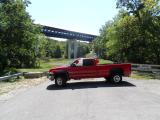Everything posted by diesel4life
-
Pilothouse/RAM3500 build
I just logged in to say she's looking good! What are your plans for the doors now that you have stretched the cab?
-
Teardown and Rebuild
Same as these https://www.genosgarage.com/product/bil-24-185776/bilstein-front
-
Teardown and Rebuild
Cummins recommends plugging in at 0*F and colder. It surely doesn't hurt to plug them in in warmer temps (except for the wallet) I generally plug in once it dips down into the single digits unless I'm at work, then I plug in pretty much all the time during the winter months LOL.
-
Teardown and Rebuild
Or it could be the injectors people are using...I've started dozens of 12 & 24 valve CAPS engines over the years in construction and Ag equipment with no grid heaters and they will start just fine down into the low teens/ upper single digits. They will start down below that but will run pretty rough the first several seconds. We try to plug them in anyway when it gets that cold. On my truck I don't even wait for the grid heaters until the temps drop down below 15 or so degrees.
-
Hard to start
The lift pump isn't ideal but likely not the problem here. You'd be surprised how many guys are still running around on the OEM lift pumps. I know a guy with an 01 with original VP AND block mounted Carter lift pump. It's a dually with a dump body and a plow and gets worked hard every time it gets fired up. Hes not the only guy i know with the OEM set up, either. Go figure. Did you correct the slow cranking issue? Diesels need cranking speed to light off. That definitely needs addressed.
-
New CJ-4 oils in older Flat Tappet Engine
QRE which spec oil is superior, all one has to do is reference the manufacturers tests. Note the ISB test that is specific to CJ4 oils to ensure proper valve train lubrication. CJ4 oils have been around nearly 2 and a half times longer than the CI4 spec. When CJ4 was introduced it was widely anticipated that a new oil would be needed for the 2010 update. That wasn't the case. CI-4 PLUS vs. API CJ-4 Diesel Engine Tests API CI-4 PLUS API CJ-4 Diesel Engine Test Measured Parameters Fuel Sulfur Content Comments 500PPM 15PPM X CAT C-13 Oil consumption and piston deposit control, iron piston X New test, with closed crankcase ventilation X X CAT IN Oil consumption and piston deposit control, aluminum piston X Aluminum piston X X Cummins ISM High temperature sludge, soot-related wear, filter plugging X Replaces MII EGR X Cummins ISB Valve train wear X New test X X Mack T-11 Soot-related viscosity control X Higher discrimination level X Mack T-12 Ring/linear wear, bearing corrosion X New test X X GMRFWT Soot-related wear X Status quo X X Navistar 7.3 L Aeration X Status quo Also for those that are interested, some pretty good info on the new PC11 oils http://www.chevronlubematters.com/category/industry-matters/pc-11/#sthash.k99TxPMu.M9Z5cjhS.dpbs
-
Fuel lubricity
What level of bio are you seeing that is the same as straight #2? B2 and even B5 should be pretty close in price to regular #2 and shouldnt be a problem with your fuel lines.
-
Fuel lubricity
Dave you might be right on that. For some reason I thought B10 was the cut off but according to this site it is B5. http://www.natso.com/blog/truckstop-biodiesel-pump-labeling-requirements-unraveled- Not exactly an official page but seems pretty solid. Kind of unrelated but for anyone that might be interested in ethanol posting requirements for your state here it is. They vary quite a bit. http://www.fuel-testers.com/state_guide_ethanol_laws.html
-
Fuel lubricity
Every state is different in labeling requirements at the pump. Some states have to label the level of biofuel used at the pumps regardless of amount and some are not required to label anything. Ohio is not required to label their pumps if the level is below B10, and the ethanol labeling requirements are even more lax than biodiesel.
-
Fuel lubricity
Again referring to the Cummins page, " What materials are incompatible with biodiesel? Natural rubber, butyl rubber and some types of nitrile rubber (depending on chemical composition, construction and application) may be particularly susceptible to degradation. Also, copper, bronze, brass, tin, lead and zinc can cause deposit formations. The use of these materials and coatings must be avoided for fuel tanks and fuel lines. Fuel fittings and connectors are acceptable due to the small surface area in contact with the fuel. Note: Contact your vehicle manufacturer to determine if any of the OEM supplied components are at risk with biodiesel in order to prevent engine or vehicle damage." So the rubber fuel lines are the primary concern however the early VPs did have a brass bushing and brass is one of the compatibility issues. If your pump has been replaced in the last several years it shouldn't be an issue so long as you don't get a bad batch get by the filters. The other reason not mentioned is filtration. The older trucks have poor filtration when it comes to bio, you need a good 2 stage filtration at a minimum and our trucks didn't come with them from the factory. It all comes down to personal preference but I'm not sure why anybody would WANT to run higher doses of bio. Just changing your filters out an extra round will negate any minor advantage in price (along with the slight decrease in mileage). I see the advantage in running B2 or even B5 for lubricity reasons. B2 offers nearly 2 and a half times better HFRR improvement over the 2 cycle mix that many like to use on this forum. Much beyond that and the potential problems that can arise pushes it past the point of diminishing returns for me. Part of the reason I posted the Cummins link was for their requirements on fuel standards and storage. It is nearly impossible for us to know where our fuel has come from, how its been handled and how long it's been stored. Another quote from Mercedes in the link I posted: "The problems seem to be occurring in distribution and Mercedes reported that (in 2014) as much as 15% of retail biodiesel was out of spec. There is little regulation or concern at this point as to what happens to the product once it leaves the terminal. Our infrastructure transports and stores bio much the same as it does regular #2 and that is where the problems arise. Until there are better laws and regulations put in place to transport, and store biodiesel the problems will continue.
-
Fuel lubricity
If your truly interested on the effects of biofuels and what OEMs have to say about them, here is a good read. http://www.theenergycollective.com/jared-anderson/450416/fuel-stability-problems-challenge-fame-biodiesel Here is what Cummins has to say, take note of the part where they talk about maintenance intervals when switching from #2 to B20: "Due to the solvent nature of B20, and the potential for ‘cleaning’ of the vehicle fuel tank and lines, new fuel filters must be installed when switching to B20 on used engines. Fuel filters will need to be replaced at half the standard interval for the next two fuel filter changes. After this initial period, you may revert to the intervals specified in your O & M manual. For EPA 2007 on-highway midrange engines only, oil sampling will be necessary for the first 6 months of operation with B20 to monitor fuel dilution of the lubricating oil." http://cumminsengines.com/biodiesel-faq More opinions from OEMs http://www.eia.gov/conference/2014/pdf/presentations/woebkenberg.pdf
-
Fuel lubricity
Now we are editing my posts because I stated someone was mis stating facts?? Wow.
-
Fuel lubricity
LOL, if you think bio is the end all cure to diesel fuel quality you are sorely mistaken. The ONLY reason we have bio fuels is due to government driven subsidies and mandates. It has absolutely nothing to do with it being a superior product to #2. If it was superior the EMA and ASTM would recommend and possibly demand its use, as it is they say you MAY use up to x amount BUT knowing the quality of the fuel is YOUR responsibility, and your warranty WILL be voided if/when you get a bad dose. The only saving grace for bio is its lubricating properties, aside from that #2 is superior in every way. Ever see a dmaaged fuel system from a bad batch of bio? It ain't pretty.Bio is much worse than ULSD in terms of water retention and solvency, even worse than gasoline and methanol.
-
Fuel lubricity
Biodiesel has a higher and narrower boiling range than regular diesel fuel, and does not evaporate from the crank case like #2 does. and because of its molecular structure it atomizes in Larger droplets coming out of the injector. This is particularly a problem in engines that use post injection cycles to burn the soot out of the DPF. Engine oil companies add specific antioxidants and additives to counter this. Second, biodiesel that has been incorrectly mixed or stored (or stored too long) will plug filters regardless of the time of year, winter simply has a tendency to show b weaknesses quicker than #2.
-
Fuel lubricity
Material compatibility (particularly rubber hoses), oil dilution,corrosion, filter plugging, decreased fuel mileage are all potential drawbacks associated with running higher blends of bio. Not to mention the higher the concentration the more prone the fuel is to mishandling at the terminal and fuel stations. I think I mentioned before I run B5 from a trusted station but am very hesitant to run anything more than that especially from an unknown source.
-
Fuel lubricity
Correct, due to the cleaniness of the combustion of the engine which is contrary to the statement about engine wear. SCR trucks are cleaner and more efficient inside and out than our VP trucks could ever be. To the OP, nothing politically motivated about any of my comments. The EPA has driven the fuel standards we use today so its all relevant. You just brought up another question regarding a govt mandated policy so don't be disappointed when another "politically" related discussion surfaces.
-
Fuel lubricity
Current OCI on the Cummins is double what ours is....I'd say Cummins disagrees with your statement. Not trying to pick an argument here guys but without the EPA where would we be? (Take a CLOSE look at China with their recent industrial boom and lack of regulations and what has been going on over there to get an idea)
-
Fuel lubricity
The SCR equipped trucks are every bit of 1500-2000 lbs heavier than the 2nd gens, put out twice the torque, provide very similar mpg running empty and will return better towing mpg than a 2nd gen...and does so at emissions levels that rival todays gasoline engine. If that's not progress, Im not sure what is! Sure there are people in power in the EPA that have questionable ethics and motives but the same could be said for every entity whether it be the government or private sector. But the truth is the EPA has cleaned our country up immensely over the last 50 years. I've never lived in a big city but those that have and can remember all the smog warnings and acid rains of the 70s and 80s can attest to that. School systems had to watch the smog forecast to decide whether or not to let kids out for recess everyday! Imagine that!! Remember when the Cuyahoga River burned? (It burned countless times during the 50's-60's). Ive fished in the Cuyahoga several times over the years, thanks to the 10 year dredging project in the 90's. Alot has changed since those days, and personally I think it's for the better!! But that's just me.
-
Teardown and Rebuild
I certainly understand and appreciate everybody has different tastes, but I must be missing something... you've got a clean 2nd gen with a fresh engine and paint, what kind of build are you shooting for? The only bumpers that will protect the intercooler/radiator are the ones that have the brush guards built integraly with the bumper, and they must be made of heavy schedule pipe. The lighter weight bumpers with thin schedule material that are built tight to the truck for a streamlined appearance are mostly for cosmetic purposes. I work with 2 guys that have what I call show bumpers, both tagged deer and both had to replace the entire front end of the truck along with their bumpers. One guy got away with replacing only the front clip, good, and bumper, but the other did over $4500 in damage (the bumper only added to the cost of repairs) I've not seen the ones in person in the link but the only ones that look capable of offering adequate protection from say a deer at highway speeds is the "Rancher" bumper, or possibly the one with the bull nose depending on how you hit them, both of which seems to have taken a few design ques from you know who. I don't think they're much cheaper (if at all) by the time you figure in time and material to build it, then pay to have it sandblasted and powdercoated. It all comes down to preference, but I'm a function over form kinda guy (and don't think the Ranch Hands look bad to begin with) https://youtu.be/QGPYqOhRQkY Ok, done hijacking!
-
Teardown and Rebuild
Bumpers like this are more for show than anything. They look good but will not protect you any better in all but the lowest collisions.I know alot of people don't like the Ranch hands but mine has saved the front of my truck twice now. Worth every penny in my book.
-
Fuel lubricity
Even 2% bio improves the HFRR of untreated fuel nearly 2 and a half times more than 2 cycle oil. Ever since my local fuel station started carrying B5 I don't even bother with a lubricant. In the winter time I will use Schaeffers diesel treat (winter blend) as a precaution, the last two winters here have been much colder than average and there were a few days over the course of the winter that I saw trucks pulled off on the side of the road. I suggested to my foreman we dose the fuel tanks on our cranes but he didn't see a need for it. One morning we came in it was -38F and the filters plugged solid upon start up. Cost us about 6 hours in the middle of a shutdown. After that fiasco, he gave me a company credit card and sent me shopping.
-
Teardown and Rebuild
I run a 5" exhaust but only because it was practically given to me (new, never installed). It did not come with a muffler/resonator so I tried without, personally I think it's obnoxious loud! Not so bad driving solo but I ran a 600 mile trip towing my 22 ft tilt trailer with a half ton Ford on the back and that 600 miles cured me of ever wanting to run anything straight piped again! The drone was absolutely horrible. We were in the process of scrapping a dump truck and it had a good Shuttleworth muffler on it so I saved it and spliced it into my truck. Much better but truthfully it could still use a resonator. If I buy another exhaust it will be a 4", in my opinion the 5 is a little much for these trucks.
-
Quick VP44 Install Question (need ASAP)
My former 2000 was cracked on the exact same cover. The guy thought the VP was toast because it was leaking fuel out the back and was hard starting when sitting for a while. I bought the truck cheap, pulled the pump, found the cracked cover, tig welded it up and installed new o rings and reassembled. Truck ran great for the next 150k or so miles that I owned it.
-
Teardown and Rebuild
Looking good! If your venting the crank case through the 12 valve tappet cover, how are you blocking off the front of the cover? On the VP marine pistons I never even knew there was such a thing as a VP marine engine. With marine emissions requirements being similar to off road/construction/Ag engines I thought they went straight from the 12 valve head/P Pump to 24 valve CR.
-
Lets see who you are!
My boys (2 on the left) and my friends boys out for a ride early this spring. They are all close in age between 9 and 11 and are good buds. Last weekend We are loading up and heading to Mines and Meadows on Sunday. Several miles of underground trails, streams, and large ponds. I hope everyone has a Great Independence Day!





